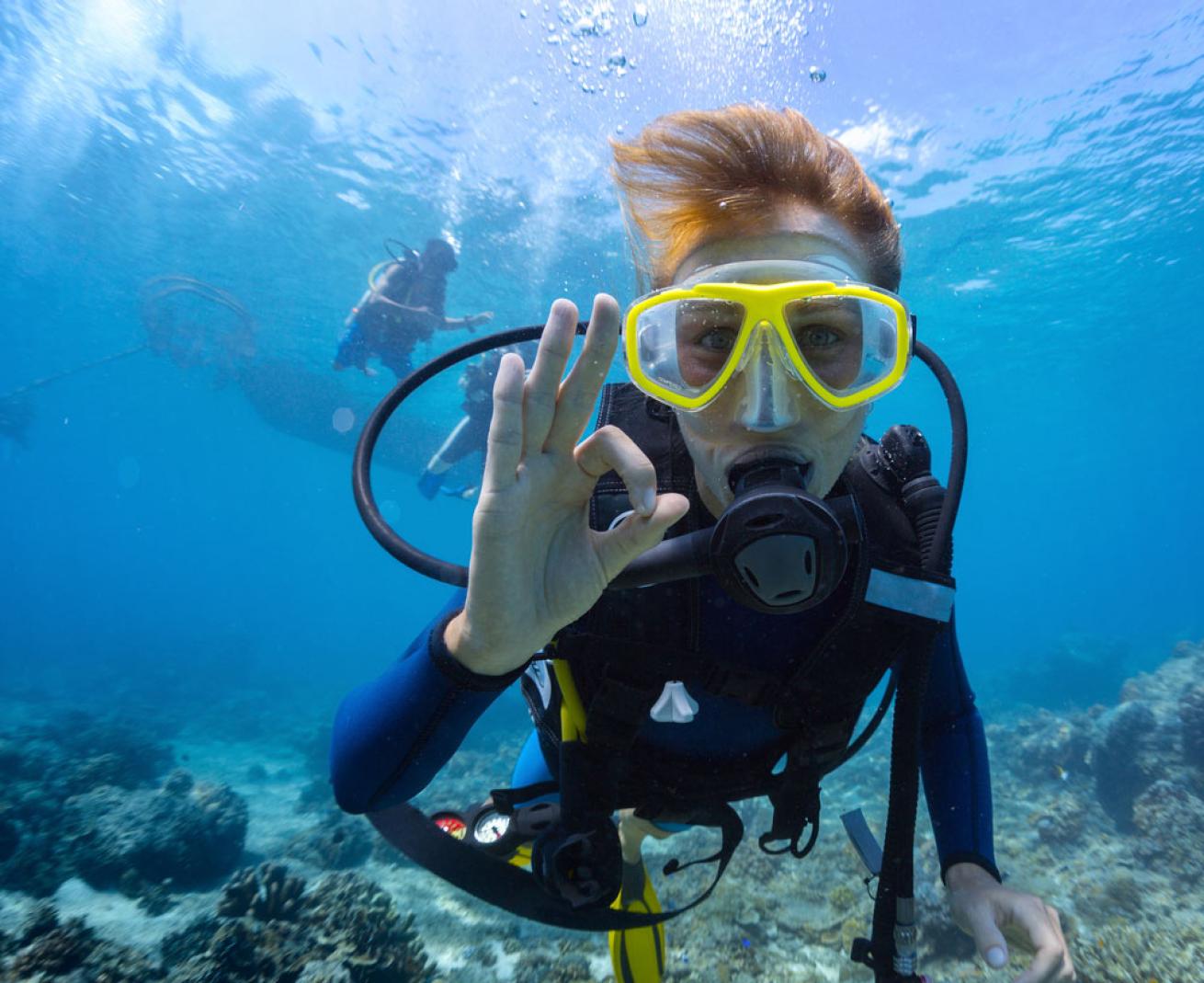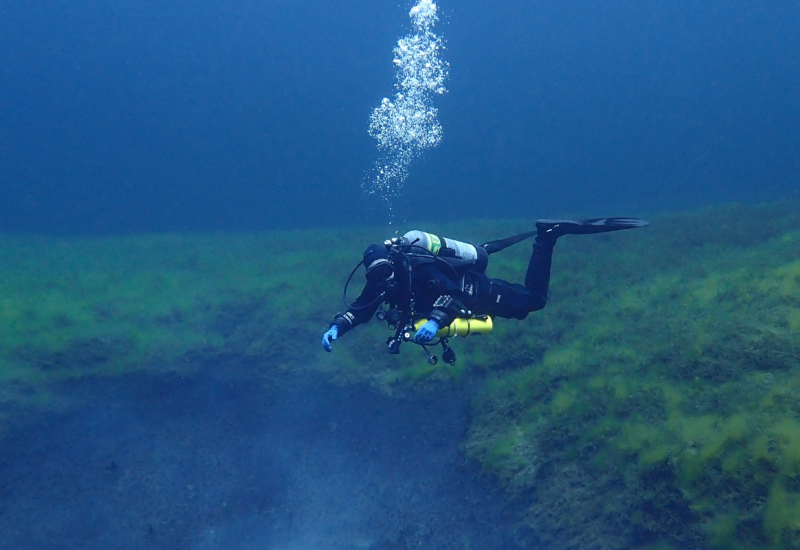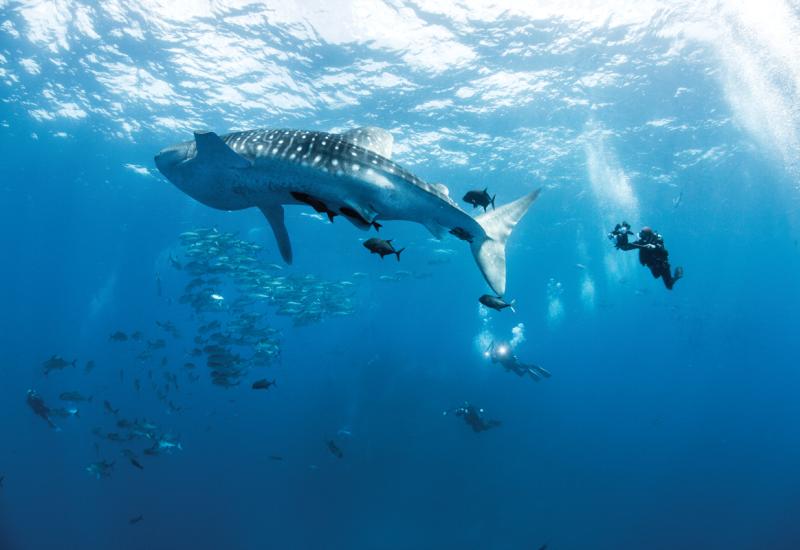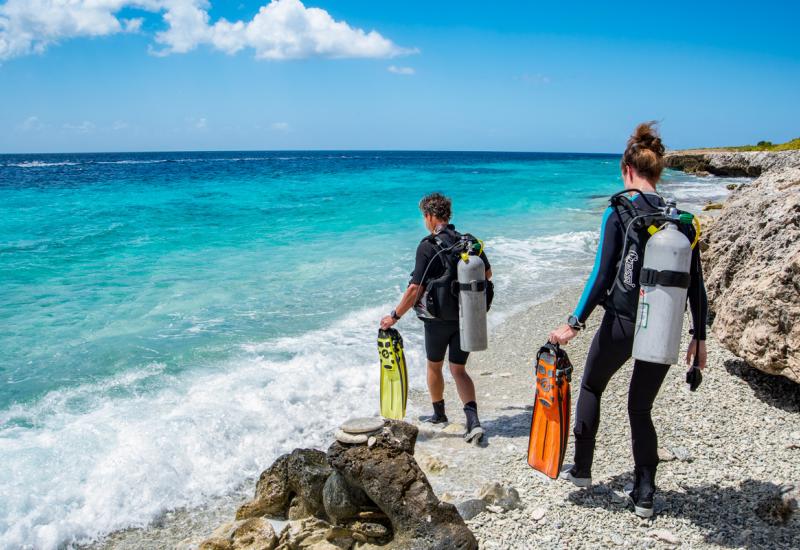10 Myths About Diving

Shutterstock
Myth: Diving — that was my grandfather's sport
Truth: If you think scuba isn't extreme enough for you, you're not seeing past the first step. Sure, a lot of people never go beyond puttering around in nice, calm water, looking at nice, calm fish. But if you get the right training and equipment, you can get radical with this sport. Try swimming through the surf zone off Southern California and it's you who'll need the Geritol, not Grandpa. Need more? Ever hand-feed a shark? Explore the far reaches of a flooded cave? Chase a 400-pound fish through the legs of an offshore oil rig? Go inside the rusting hallways of a sunken ocean liner? Swim beneath the polar ice caps? These are just some of the experiences that divers — and only divers — get to have. But you've got to build up to it, junior. So check your ego at the door, show Gramps a little respect and take the first step — earning Open-Water certification — before you start talking smack. Or better yet, pull Grandpa aside and ask him to tell you about that dive he never told Grandma about.
Myth: Diving is only for people who live in the tropics
Truth: There are few things that rival the experience of being suspended weightlessly in warm, clear tropical water while floating effortlessly along a colorful coral reef. Unless, of course, it is the experience of drifting through a California kelp bed with a pod of sea lions. Or exploring the amazingly preserved ruins of a wooden shipwreck in Lake Michigan. Or finding a million-year-old shark tooth completely intact in South Carolina's Cooper River, or ... the list goes on and on.
No matter where you are, chances are there's a popular dive site somewhere nearby. Don't believe me? Just ask anyone with the red and white diver down flag on his car. Lakes, quarries, rivers, flooded mineshafts — almost anywhere there's water, you'll find divers. Heck, outside of Abilene, Texas, you can even dive in a flooded underground missile silo. Each of these sites provides its own unique dive experience and a chance to get started in the sport. Not every dive site is for every diver, but scuba diving is not just a sport, it's also a lifestyle and a very social activity. So even if your local swimming hole isn't a world-famous dive site, an outdoor grill, a cooler, a couple of tanks of air and a dozen of your new best friends can still make for a whole lot of fun--palm trees, optional.
Myth: There are sharks in the ocean and they eat divers. Don't try to deny it — I saw Jaws and Open Water
Truth: Don't tell Hollywood, but the factual record on shark vs. diver is pretty dull: Sharks just don't make a habit of munching on divers. In fact, except in certain conditions and environments, they don't even stick around when divers get in the water. Let's look at it from the shark's point of view. You're out cruising the depths, when out of nowhere this noisy, bubble-blowing pack of creatures that looks and moves like nothing else in the ocean drops into the water and starts flashing lights (i.e., camera strobes) at you. It's got to be the shark equivalent of Close Encounters. The first thing most sharks do? Turn tail and run.
It used to be that divers could go their whole lives without ever seeing the beauty and majesty of a shark up close. Today, carefully managed encounter dives — from cage diving with great whites off Australia to hand-feeding reef sharks in the Bahamas — abound, and there is no better way to gain a true understanding of these amazing creatures than to see them up close.
Still not convinced? Then let me give you something serious to worry about instead: your dog. Yep. Behind those puppy dog eyes and that happy-to-see-you personality lurks the heart of a cold-blooded predator that's statistically far more dangerous than any shark. According to emergency room records, "man's best friend" killed 27 and seriously injured or maimed 4.7 million people in 2005, and that was just in the U.S. According to the International Shark Attack File, only four people worldwide died from shark attacks in the same 12-month period, out of 58 total recorded incidents. Based on those odds, you're safer in the ocean than taking Rover for a walk.
Myth: I have to buy a ton of gear just to learn
Truth: Scuba is a gear-intensive sport, but you only need three basic items to start lessons — a mask, a snorkel and a pair of fins. These are personal gear items and they need to fit well for you to have a good time, so it's worth buying them even if the shop provides loaners.
All the other gear is available to rent, usually at a discount rate to students, and sometimes the use of the more complex equipment is included in the dive package price.
Once you are a full-fledged diver, you will ultimately want to purchase your own gear. It will be tempting to max out the plastic and buy everything in one fell swoop, and if you've got the room on your cards, go for it. But most beginning divers continue to make use of rental gear and acquire their own items one piece at a time.
Myth: You have to be a speedo-sporting competitive swimmer to be a diver
Truth: Sure, ultra-fit, competitive swimmers make great divers because they're comfortable in the water and they're in great shape, but if the logic of this myth were true, I suppose only Tour de France racers would ride bikes.
Diving is an active sport and the better shape you're in, the easier it will be, but any healthy individual with at least an average fitness level can do it. This myth is most likely fueled by the fact that there is a basic swim test at the start of scuba lessons. You'll need the endurance to swim about 200 yards nonstop, but there's no time limit and it's not a race. The instructor also needs to know that you have basic water skills and are comfortable submerging your face in water. That's it. And when you consider that there are divers from age eight to age 80 who have passed this grueling test of physical ability, it's pretty clear that anyone with an activity level above that of a chronic couch potato can do it. So, get off the couch and go diving already. And please — regardless of your fitness level--leave the Speedo at home. OK?
Myth:Diving is a macho sport that is not female-friendly
Truth: This might have been true, back in the 1950s Sea Hunt era when men of steel like Mike Nelson (played by the late, great Lloyd Bridges) were out there spearing fish with their bare hands and rescuing damsels in distress. Only it wasn't really true then, either. The lovely Zale Parry, the actress who played the damsel, was one of the most accomplished divers on the set. And when Sports Illustrated decided to feature the young sport of scuba diving in its May 23, 1955, issue, it was Parry who made the cover.
It is true, however, that men have always participated in the sport more than women, but the gap has been closing steadily since the 1980s. Today, the male/female ratio is roughly 60/40 and everyone from equipment manufacturers to tour operators offer products specifically for female divers. And there's no glass ceiling to this sport — there are female instructors, divemasters, boat captains and resort owners.
Myth: Diving will make my ears hurt
Truth: This one's true — but only if you don't equalize the pressure in your ears as you descend. That's one of the first things they teach you to do in scuba lessons. It's called the Valsalva manuever and it's falling-down simple: Pinch your nose and blow gently against your nostrils until you feel relief. Try it. See? It's easy. Don't you wish you'd known this trick back in fifth grade when you were diving for quarters at the bottom of the YMCA pool?
Myth: Certification is way too expensive
Truth: You don't get out much, do you? Check the price for a decent dinner, movie tickets for two, throw in some popcorn, after-movie coffees and you'll drop $100 — easily — assuming, of course, there was no drive-through involved in ordering dinner. So, how does that compare to scuba? Depending on where you are in the country, the average certification class runs between $250 and $500, or just a few of those dinner-and-a-movie dates. In return, you get an all-access pass to a world of aquatic adventure, not to mention a great new lifestyle you can brag about at the office. Go on: Compare the cost of scuba lessons to almost anything and you'll see it's a bargain, especially compared to greens fees, lift tickets and the cost of that home gym collecting dust in your guest room.
Myth: I can't dive. I have (insert name of medical condition here)
Truth: Why not get a second opinion? Doctors are a very cautious bunch and often don't understand the sport of diving, so if you ask about scuba with regard to a specific medical condition, their likely answer will be the safe one: No.
But before you let a lifetime of adventure slip away, you and your doctor should consult the diving medicine experts at the Divers Alert Network (DAN). This nonprofit safety organization is affiliated with the Duke University Medical Center, and they can help you better understand the physical demands of diving and how it relates to your health. Call their nonemergency questions line at (919) 684-2948 and you may be surprised to find the answer is: Yes, you can dive safely.
In just the past 10 years, for example, asthma and diabetes have gone from being absolute disqualifiers to conditional ones. In both cases, if the condition is carefully monitored and controlled, and the patient can tolerate physical exercise, the pool is usually open.
Myth: Snorkeling is just as good as scuba diving
Truth: Don't get me wrong. I like to snorkel — floating around on the surface peering down on the reef from above is a great way to spend time between dives. But just as good? No way! Not if you like action.
Snorkeling is sort of like watching a football game from the window of the Goodyear blimp high above. Diving is like suiting up, running down the tunnel and getting in the game. Strap a tank on your back and you are a player — swimming with the sharks as equals, getting up close and personal with giant Goliath grouper, or, for a good laugh, looking up and seeing the soft, bulging underbellies of all those snorkelers drifting like flotsam on the surface and blocking out the sunlight.
Scuba diver image courtesy of Shutterstock.

ShutterstockDon't let these common misconceptions about scuba diving hold you back.
Myth: Diving — that was my grandfather's sport
Truth: If you think scuba isn't extreme enough for you, you're not seeing past the first step. Sure, a lot of people never go beyond puttering around in nice, calm water, looking at nice, calm fish. But if you get the right training and equipment, you can get radical with this sport. Try swimming through the surf zone off Southern California and it's you who'll need the Geritol, not Grandpa. Need more? Ever hand-feed a shark? Explore the far reaches of a flooded cave? Chase a 400-pound fish through the legs of an offshore oil rig? Go inside the rusting hallways of a sunken ocean liner? Swim beneath the polar ice caps? These are just some of the experiences that divers — and only divers — get to have. But you've got to build up to it, junior. So check your ego at the door, show Gramps a little respect and take the first step — earning Open-Water certification — before you start talking smack. Or better yet, pull Grandpa aside and ask him to tell you about that dive he never told Grandma about.
Myth: Diving is only for people who live in the tropics
Truth: There are few things that rival the experience of being suspended weightlessly in warm, clear tropical water while floating effortlessly along a colorful coral reef. Unless, of course, it is the experience of drifting through a California kelp bed with a pod of sea lions. Or exploring the amazingly preserved ruins of a wooden shipwreck in Lake Michigan. Or finding a million-year-old shark tooth completely intact in South Carolina's Cooper River, or ... the list goes on and on.
No matter where you are, chances are there's a popular dive site somewhere nearby. Don't believe me? Just ask anyone with the red and white diver down flag on his car. Lakes, quarries, rivers, flooded mineshafts — almost anywhere there's water, you'll find divers. Heck, outside of Abilene, Texas, you can even dive in a flooded underground missile silo. Each of these sites provides its own unique dive experience and a chance to get started in the sport. Not every dive site is for every diver, but scuba diving is not just a sport, it's also a lifestyle and a very social activity. So even if your local swimming hole isn't a world-famous dive site, an outdoor grill, a cooler, a couple of tanks of air and a dozen of your new best friends can still make for a whole lot of fun--palm trees, optional.
Myth: There are sharks in the ocean and they eat divers. Don't try to deny it — I saw Jaws and Open Water
Truth: Don't tell Hollywood, but the factual record on shark vs. diver is pretty dull: Sharks just don't make a habit of munching on divers. In fact, except in certain conditions and environments, they don't even stick around when divers get in the water. Let's look at it from the shark's point of view. You're out cruising the depths, when out of nowhere this noisy, bubble-blowing pack of creatures that looks and moves like nothing else in the ocean drops into the water and starts flashing lights (i.e., camera strobes) at you. It's got to be the shark equivalent of Close Encounters. The first thing most sharks do? Turn tail and run.
It used to be that divers could go their whole lives without ever seeing the beauty and majesty of a shark up close. Today, carefully managed encounter dives — from cage diving with great whites off Australia to hand-feeding reef sharks in the Bahamas — abound, and there is no better way to gain a true understanding of these amazing creatures than to see them up close.
Still not convinced? Then let me give you something serious to worry about instead: your dog. Yep. Behind those puppy dog eyes and that happy-to-see-you personality lurks the heart of a cold-blooded predator that's statistically far more dangerous than any shark. According to emergency room records, "man's best friend" killed 27 and seriously injured or maimed 4.7 million people in 2005, and that was just in the U.S. According to the International Shark Attack File, only four people worldwide died from shark attacks in the same 12-month period, out of 58 total recorded incidents. Based on those odds, you're safer in the ocean than taking Rover for a walk.
Myth: I have to buy a ton of gear just to learn
Truth: Scuba is a gear-intensive sport, but you only need three basic items to start lessons — a mask, a snorkel and a pair of fins. These are personal gear items and they need to fit well for you to have a good time, so it's worth buying them even if the shop provides loaners.
All the other gear is available to rent, usually at a discount rate to students, and sometimes the use of the more complex equipment is included in the dive package price.
Once you are a full-fledged diver, you will ultimately want to purchase your own gear. It will be tempting to max out the plastic and buy everything in one fell swoop, and if you've got the room on your cards, go for it. But most beginning divers continue to make use of rental gear and acquire their own items one piece at a time.
Myth: You have to be a speedo-sporting competitive swimmer to be a diver
Truth: Sure, ultra-fit, competitive swimmers make great divers because they're comfortable in the water and they're in great shape, but if the logic of this myth were true, I suppose only Tour de France racers would ride bikes.
Diving is an active sport and the better shape you're in, the easier it will be, but any healthy individual with at least an average fitness level can do it. This myth is most likely fueled by the fact that there is a basic swim test at the start of scuba lessons. You'll need the endurance to swim about 200 yards nonstop, but there's no time limit and it's not a race. The instructor also needs to know that you have basic water skills and are comfortable submerging your face in water. That's it. And when you consider that there are divers from age eight to age 80 who have passed this grueling test of physical ability, it's pretty clear that anyone with an activity level above that of a chronic couch potato can do it. So, get off the couch and go diving already. And please — regardless of your fitness level--leave the Speedo at home. OK?
Myth: Diving is a macho sport that is not female-friendly
Truth: This might have been true, back in the 1950s Sea Hunt era when men of steel like Mike Nelson (played by the late, great Lloyd Bridges) were out there spearing fish with their bare hands and rescuing damsels in distress. Only it wasn't really true then, either. The lovely Zale Parry, the actress who played the damsel, was one of the most accomplished divers on the set (she helped teach Bridges how to dive). And when Sports Illustrated decided to feature the young sport of scuba diving in its May 23, 1955, issue, it was Parry who made the cover.
It is true, however, that men have always participated in the sport more than women, but the gap has been closing steadily since the 1980s. Today, the male/female ratio is roughly 60/40 and everyone from equipment manufacturers to tour operators offer products specifically for female divers. And there's no glass ceiling to this sport — there are female instructors, divemasters, boat captains and resort owners.
Myth: Diving will make my ears hurt
Truth: This one's true — but only if you don't equalize the pressure in your ears as you descend. That's one of the first things they teach you to do in scuba lessons. It's called the Valsalva manuever and it's falling-down simple: Pinch your nose and blow gently against your nostrils until you feel relief. Try it. See? It's easy. Don't you wish you'd known this trick back in fifth grade when you were diving for quarters at the bottom of the YMCA pool?
Myth: Certification is way too expensive
Truth: You don't get out much, do you? Check the price for a decent dinner, movie tickets for two, throw in some popcorn, after-movie coffees and you'll drop $100 — easily — assuming, of course, there was no drive-through involved in ordering dinner. So, how does that compare to scuba? Depending on where you are in the country, the average certification class runs between $250 and $500, or just a few of those dinner-and-a-movie dates. In return, you get an all-access pass to a world of aquatic adventure, not to mention a great new lifestyle you can brag about at the office. Go on: Compare the cost of scuba lessons to almost anything and you'll see it's a bargain, especially compared to greens fees, lift tickets and the cost of that home gym collecting dust in your guest room.
Myth: I can't dive. I have (insert name of medical condition here)
Truth: Why not get a second opinion? Doctors are a very cautious bunch and often don't understand the sport of diving, so if you ask about scuba with regard to a specific medical condition, their likely answer will be the safe one: No.
But before you let a lifetime of adventure slip away, you and your doctor should consult the diving medicine experts at the Divers Alert Network (DAN). This nonprofit safety organization is affiliated with the Duke University Medical Center, and they can help you better understand the physical demands of diving and how it relates to your health. Call their nonemergency questions line at (919) 684-2948 and you may be surprised to find the answer is: Yes, you can dive safely.
In just the past 10 years, for example, asthma and diabetes have gone from being absolute disqualifiers to conditional ones. In both cases, if the condition is carefully monitored and controlled, and the patient can tolerate physical exercise, the pool is usually open.
Myth: Snorkeling is just as good as scuba diving
Truth: Don't get me wrong. I like to snorkel — floating around on the surface peering down on the reef from above is a great way to spend time between dives. But just as good? No way! Not if you like action.
Snorkeling is sort of like watching a football game from the window of the Goodyear blimp high above. Diving is like suiting up, running down the tunnel and getting in the game. Strap a tank on your back and you are a player — swimming with the sharks as equals, getting up close and personal with giant Goliath grouper, or, for a good laugh, looking up and seeing the soft, bulging underbellies of all those snorkelers drifting like flotsam on the surface and blocking out the sunlight.
Scuba diver image courtesy of Shutterstock.










